|
 |
| Adult, San Mateo County © Bob Cossins |
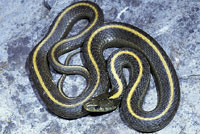 |
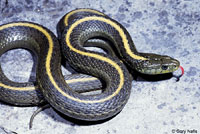 |
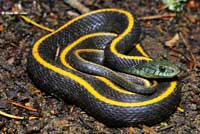 |
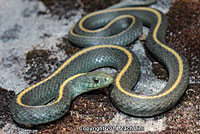 |
| Adult, Santa Cruz Mountains, Santa Cruz County. |
Adult, San Mateo County
© Chad M. Lane |
Adult, Santa Cruz County © Zachary Lim |
 |
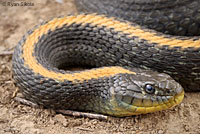 |
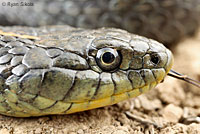 |
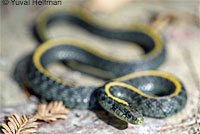 |
| Adult, Santa Clara County © Ryan Sikola |
Adult, San Mateo County
© Yuval Helfman |
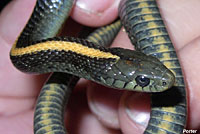 |
 |
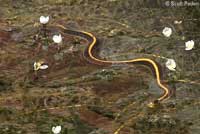 |
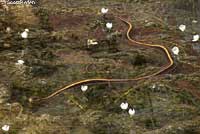 |
| Adult, San Mateo County. © Richard Porter |
Adult, Santa Cruz County © Scott Peden |
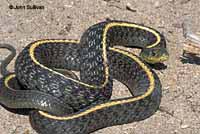 |
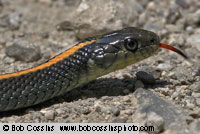 |
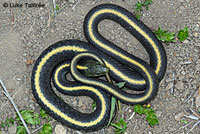 |
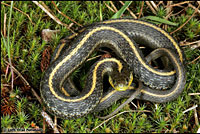 |
Adult, Santa Cruz County
© John Sullivan
|
Adult, San Mateo County © Bob Cossins |
Adult, Santa Clara County
© Luke Talltree |
Adult, Santa Cruz County
© Brad Alexander |
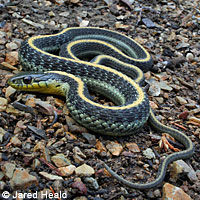 |
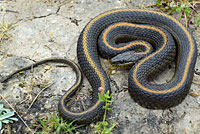 |
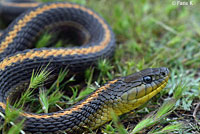 |
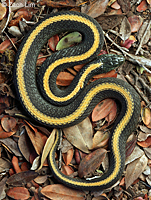 |
| Probably intergrade adult, Santa Clara County © Jared Heald |
Adult, Santa Cruz County © Faris K |
Adult, San Mateo County © Zach Lim |
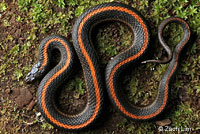 |
|
|
|
Melanistic adult, San Francisco Bay Area
© Zachary Lim |
|
|
|
| |
|
|
|
| Juveniles |
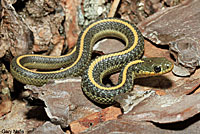 |
 |
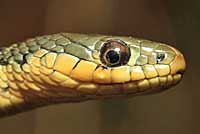 |
|
| Juvenile, Santa Cruz County |
|
| |
|
|
|
| Comparisons With Sympatric Gartersnakes |
 |
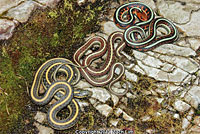 |
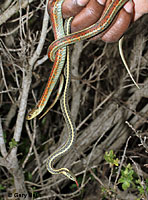 |
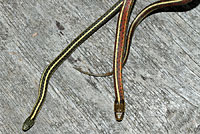 |
Three species of gartersnakes found at the same Marin County location:
Right - Thamnophis atratus
Bottom left - Thamnophis sirtalis
Top - Thamnophis elegans
© Luke Talltree |
Three species of gartersnakes found at the same Marin County location:
Top - Thamnophis sirtalis
Middle - Thamnophis elegans
Bottom - Thamnophis atratus
© Zach Lim |
Two Marin County snakes:
Coast Gartersnake on top;
Aquatic Gartersnake on bottom. |
Two Marin County snakes:
Aquatic Gartersnake on left;
Coast Gartersnake on right.
|
| |
|
|
|
| Feeding |
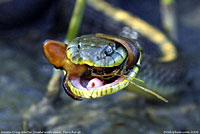 |
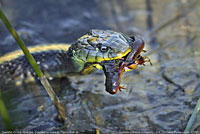 |
|
|
Two views of a Santa Cruz Gartersnake eating a newt
(either Taricha torosa or Taricha granulosa) in Santa Clara County
© Odophile.com |
|
|
| |
|
|
| Breeding Behavior |
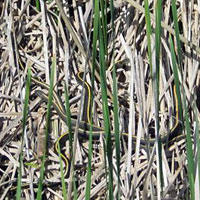 |
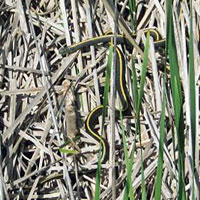 |
 |
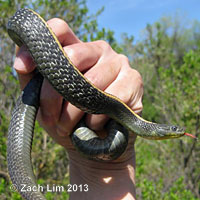 |
A group of breeding Santa Cruz Gartersnakes photographed in late March in San Mateo County.
Snakes were moving constantly in the reeds and across trails heading towards the reeds. They're not easy to see, but if you look carefully at the enlarged images, you can see several snakes in various areas of each picture. © Zachary Lim
|
This one was picked up and photographed as it was heading into the reeds. © Zachary Lim |
| |
|
| Intergrades |
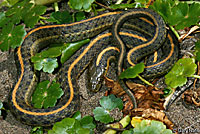 |
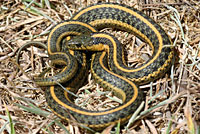 |
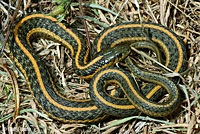 |
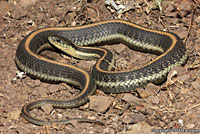 |
| Adult intergrade, Marin County. |
Adult intergrade, Marin County. |
Adult intergrade, Marin County. |
Adult from Marin County Headlands, just northwest of the Golden Gate Bridge
© Zach Lim |
 |
|
|
|
Possible T. a. atratus x T. a. zaxanthus intergrade adult, Santa Clara County
© Jared Heald |
|
|
|
| North of the San Francisco Bay, there is a very large intergrade range between T. a. hydrophilus, T. a. atratus, and T. a. zaxanthus. The snakes in this area were formerly classified as T. a. aquaticus (previously T. couchii aquaticus.) This subspecies is no longer recognized. More pictures and information about these intergrades can be seen here. |
| |
|
| Habitat |
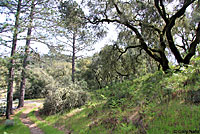 |
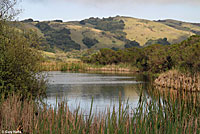 |
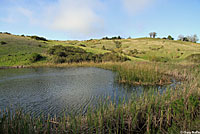 |
 |
Habitat, Santa Cruz County
|
Habitat, Santa Clara County |
Habitat, Santa Clara County |
Habitat, San Mateo County |
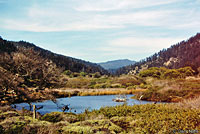 |
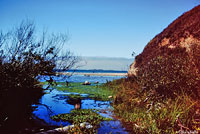 |
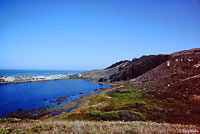 |
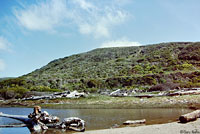 |
| Habitat, San Mateo County |
Habitat, San Mateo County |
Habitat, San Mateo County |
Habitat, San Mateo County |
 |
|
|
|
Habitat, Santa Cruz Mountains
© Zachary Lim |
|
|
|
| |
|
|
|
| Short Video |
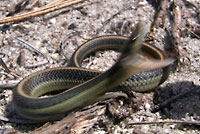 |
|
|
|
| A feisty juvenile Santa Cruz Gartersnake in the Santa Cruz Mountains. |
|
|
|
|
|
|
|
|
Description |
Not Dangerous - This snake may produce a mild venom that does not typically cause death or serious illness or injury in most humans, but its bite should be avoided.
Commonly described as "harmless" or "not poisonous" to indicate that its bite is not dangerous, but "not venomous" is more accurate since the venom is not dangerous. (A poisonous snake can hurt you if you eat it. A venomous snake can hurt you if it bites you.)
Long-considered non-venomous, discoveries in the early 2000s revealed that gartersnakes produce a mild venom that can be harmful to small prey but is not considered dangerous to most humans, although a bite may cause slight irritation and swelling around the puncture wound. Enlarged teeth at the rear of the mouth are thought to help spread the venom.
|
| Size |
Adults are 18 - 40 inches long (46 - 102 cm). Most snakes encountered are generally 18 - 28 inches long (46 - 71 cm).
Neonates are 7 - 10 inches ( 18 - 25 cm).
|
| Appearance |
A medium-sized slender snake with a head barely wider than the neck and keeled dorsal scales.
Some average scale counts: Average of 8 upper labial scales, 6 and 7 not enlarged. 11 lower labial scales. Rear pair of chin shields is longer than the front. The internasals are longer than they are wide and pointed in front. Average of 19 or 21 scales at mid-body.
The following description is from Boundy, Jeff. Systematics of the Garter Snake Thamnophis atratus at the Southern End of Its Range. Proceedings of the California Academy of Sciences Volume 51, No. 6, p. 330. 1999.
"...midbody scale rows 19 (65%) or 17 (35%) ... vertebral stripe yellow to orange yellow and broad, averaging 4.0 (range 2.7 - 6.5) scale rows in the nuchal area ... lateral stripes absent; dorsum olive black, grading to dark olive at the ventrals; dorsal black spots obscure; iris dark brown; top of head dark olive brown to olive black, with a prominent parietal spot; supralabial suture marks narrow when present; demarcation between dorsal head color and dusky olive supralabials indistinct; chin cream, becoming deep yellow on the throat; venter abruptly becoming olive gray in the thoracic area, continuously darkening posteriorly; prominent yellow-orange midventral suffusion; dark markings absent from transverse ventral sutures..."
|
| Color and Pattern |
Ground color is gray, brown or black.
There is a wide yellowish to orange-yellow dorsal stripe, but with the side stripes absent or obscured.
There may be small alternating dark spots on the sides.
The throat is white or yellow, sometimes bright yellow.
The underside is bluish or greenish sometimes with pink or yellow marks.
"In Santa Cruz Mts. (e. slope drainages) Santa Cruz Co., Calif., some lack or have faint lateral stripes, strong orange to orange-yellow dorsal stripes, yellow throat and dark bellies." (Stebbins, 2003)
|
Key to Identifying California Gartersnake Species
|
| Life History and Behavior |
Activity |
A highly-aquatic snake, able to remain underwater, but also found away from water.
Active during the day, and after dark during very hot weather.
Can be active most of the year when conditions allow, but primarily found spring through fall.
|
| Defense |
When threatened, this snake will often escape into water, hiding on the bottom. If it is frightened when picked up, it will often strike repeatedly and release feces from the cloaca and expel musk from anal glands.
|
| Diet and Feeding |
Probably eats mainly amphibians and their larvae, including frogs, tadpoles, and aquatic salamander larvae (newts and giant salamanders, Taricha and Dicamptodon ), but small fish are also eaten. Captives have also taken small rodents. Leeches may also be consumed - I saw a recently-captured T. a. zaxanthus regurgitate two leeches.
Adults tend to forage actively. Neonates are sit-and-wait foragers. Juveniles practice both types of foraging.
Preston and Johnston, 2012, in their study of the diet of T. atratus in the Bay Area, found that native amphibians are a very important part of their diet, with Sierran Treefrogs being the most important amphibian prey, followed by California Toads, California Newts, and California Red-legged Frogs.
Toxic Newts
This species has been observed eating adult Pacific Newts (genus Taricha) which are deadly poisonous to most predators.
The Bay Area is the Center of an Evolutionary Race Between Hungry Snakes and Toxic Newts.
by Anton Sorokin. Bay Nature, April 6, 2022
Gartersnakes Can Become Poisonous
There is evidence that when Common Gartersnakes (Thamnophis sirtalis) eat Rough-skinned Newts (Taricha granulosa) they retain the deadly neurotoxin found in the skin of the newts called tetrodotoxin for several weeks, making the snakes poisonous (not venomous) to predators (such as birds or mammals) that eat the snakes. Since California Newts (Taricha torosa) also contain tetrodotoxin in their skin, and since gartersnake species other than T. sirtalis also eat newts, it is not unreasonable to conclude that any gartersnake that eats either species of newt is poisonous to predators.
Williams, Becky L.; Brodie, Edmund D. Jr.; Brodie, Edmund D. III (2004). "A Resistant Predator and Its Toxic Prey: Persistence of Newt Toxin Leads to Poisonous (Not Venomous) Snakes." Journal of Chemical Ecology. 30 (10): 1901–1919.) https://doi.org/10.1023/B:JOEC.0000045585.77875.09
|
| Reproduction |
Courtship has been observed during March and April.
Females are ovoviviparous - they carry the eggs internally until the young are born live from summer to early fall.
|
| Habitat |
Creeks, streams, small lakes and ponds, in woodland, brush and forest and grassy ecotones. Seems to prefer shallow rocky creeks and streams. When found in muddy ponds there are usually rocky outcrops nearby.
|
| Geographical Range |
This subspecies, Thamnophis atratus atratus - Santa Cruz Gartersnake, is endemic to California. According to Boundy, 1999 in his revision of T. atratus into three subspecies, Thamnophis atratus atratus occurs in the "Santa Cruz Mountains and the southern San Francisco Peninsula, from the San Andreas rift lakes to the San Lorenzo River watershed and Uvas Canyon." Intergrades with T. a. zaxanthus occur in the southern Santa Cruz Mountains.
(Authorities who do not recognize T. a. zaxanthus show the range of this subspecies also occurring in the East Bay south along the coast and inner south coast ranges into Santa Barbara County.)
The species Thamnophis atratus - Aquatic Gartersnake, ranges from Santa Barbara County north through the coast ranges into southwest Oregon.
|
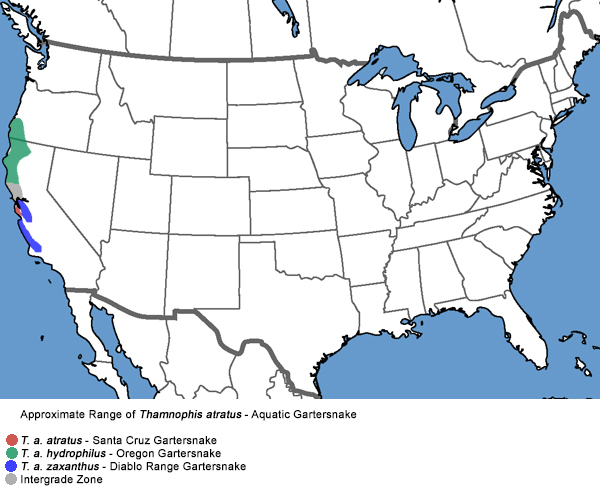 |
| Notes on Taxonomy |
This snake is known to hybridize with T. hammondii in Santa Barbara and San Luis Obispo Counties. For a long time T. atratus was considered a subspecies of T. couchii. In 1987 it was classified as a distinct species.
North of the San Francisco Bay, there is a very large intergrade range between the Oregon Gartersnake T. a. hydrophilus and T. a. atratus or T. a. zaxanthus. The snakes in this area were formerly classified as T. a. aquaticus (previously T. couchii aquaticus.)
T. atratus found in the east Bay and south along the inner coast ranges are now classified as T. a. zaxanthus by some taxonomists, including the taxonomy we follow here.
Alternate and Previous Names (Synonyms)
Thamnophis couchi atratus - Santa Cruz Garter Snake (Stebbins 1966, 1985, 2003)
Thamnophis couchi aquaticus - Aquatic Garter Snake (Stebbins 1966, 1985)
Thamnophis elegans aquaticus (Stebbins 1954)
Thamnophis elegans atratus (Stebbins 1954)
Thamnophis elegans aquaticus (Fox 1951)
Thamnophis elegans atratus (Kennicott 1860)
Black garter snake (Yarrow 1882)
Northern California coast garter
Middle California garter snake
Pacific coast garter snake
Single-striped garter snake
Western garter snake
|
| Conservation Issues (Conservation Status) |
| Not known to be threatened, but gartersnakes have been negatively impacted by competition with introduced bullfrogs in some areas. |
|
| Taxonomy |
| Family |
Colubridae |
Colubrids |
Oppel, 1811 |
| Genus |
Thamnophis |
North American Gartersnakes |
Fitzinger, 1843 |
| Species |
atratus |
Aquatic Gartersnake |
(Kennicott, in Cooper, 1860) |
Subspecies
|
atratus |
Santa Cruz Gartersnake |
(Kennicott, in Cooper, 1860) |
|
Original Description |
Thamnophis atratus - (Kennicott, 1860) - in Cooper, Expl. Surv. R.R. Miss. Pacific, Vol. 12, Book 2, Pt. 3, No. 4, p. 296
from Original Description Citations for the Reptiles and Amphibians of North America © Ellin Beltz
|
|
Meaning of the Scientific Name |
Thamnophis - Greek - thamnos = shrub or bush + ophis = snake, serpent
atratus - Latin = clothed in black, mourning - refers to the dark dorsal color
from Scientific and Common Names of the Reptiles and Amphibians of North America - Explained © Ellin Beltz
|
| Other California Gartersnakes |
T. a. hydrophilus - Oregon Gartersnake
T. a. zaxanthus - Diablo Range Gartersnake
T. couchii - Sierra Gartersnake
T. gigas - Giant Gartersnake
T. e. elegans - Mountain Gartersnake
T. e. terrestris - Coast Gartersnake
T. e. vagrans - Wandering Gartersnake
T. hammondii - Two-striped Gartersnake
T. m. marcianus - Marcy's Checkered Gartersnake
T. ordinoides - Northwestern Gartersnake
T. s. fitchi - Valley Gartersnake
T. s. infernalis - California Red-sided Gartersnake
T. s. tetrataenia - San Francisco Gartersnake
|
|
More Information and References |
California Department of Fish and Wildlife
Boundy, Jeff. Systematics of the Garter Snake Thamnophis atratus at the Southern End of Its Range. Proceedings of the California Academy of Sciences Volume 51, No. 6, pp. 311-336. 1999.
Hansen, Robert W. and Shedd, Jackson D. California Amphibians and Reptiles. (Princeton Field Guides.) Princeton University Press, 2025.
Stebbins, Robert C., and McGinnis, Samuel M. Field Guide to Amphibians and Reptiles of California: Revised Edition (California Natural History Guides) University of California Press, 2012.
Stebbins, Robert C. California Amphibians and Reptiles. The University of California Press, 1972.
Flaxington, William C. Amphibians and Reptiles of California: Field Observations, Distribution, and Natural History. Fieldnotes Press, Anaheim, California, 2021.
Nicholson, K. E. (ed.). 2025. Scientific and Standard English Names of Amphibians and Reptiles of North America North of Mexico, with Comments Regarding Confidence in Our Understanding. Ninth Edition. Society for the Study of Amphibians and Reptiles. [SSAR] 87pp.
Samuel M. McGinnis and Robert C. Stebbins. Peterson Field Guide to Western Reptiles & Amphibians. 4th Edition. Houghton Mifflin Harcourt Publishing Company, 2018.
Stebbins, Robert C. A Field Guide to Western Reptiles and Amphibians. 3rd Edition. Houghton Mifflin Company, 2003.
Behler, John L., and F. Wayne King. The Audubon Society Field Guide to North American Reptiles and Amphibians. Alfred A. Knopf, 1992.
Robert Powell, Roger Conant, and Joseph T. Collins. Peterson Field Guide to Reptiles and Amphibians of Eastern and Central North America. Fourth Edition. Houghton Mifflin Harcourt, 2016.
Powell, Robert., Joseph T. Collins, and Errol D. Hooper Jr. A Key to Amphibians and Reptiles of the Continental United States and Canada. The University Press of Kansas, 1998.
Rossman, Douglas A., Neil B, Ford, & Richard A. Siegel. The Garter Snakes - Evolution and Ecology. University of Oklahoma press, 1996.
Bartlett, R. D. & Patricia P. Bartlett. Guide and Reference to the Snakes of Western North America (North of Mexico) and Hawaii. University Press of Florida, 2009.
Bartlett, R. D. & Alan Tennant. Snakes of North America - Western Region. Gulf Publishing Co., 2000.
Brown, Philip R. A Field Guide to Snakes of California. Gulf Publishing Co., 1997.
Ernst, Carl H., Evelyn M. Ernst, & Robert M. Corker. Snakes of the United States and Canada. Smithsonian Institution Press, 2003.
Taylor, Emily. California Snakes and How to Find Them. Heyday, Berkeley, California. 2024.
Wright, Albert Hazen & Anna Allen Wright. Handbook of Snakes of the United States and Canada. Cornell University Press, 1957.
1 Daniel L. Preston and Pieter T. J. Johnson. Importance of Native Amphibians in the Diet and Distribution of the Aquatic Gartersnake (Thamnophis atratus) in the San Francisco Bay Area of California. Journal of Herpetology 46(2):221-227. 2012
|
|
|
The following conservation status listings for this animal are taken from the July 2025 State of California Special Animals List and the July 2025 Federally Listed Endangered and Threatened Animals of California list (unless indicated otherwise below.) Both lists are produced by multiple agencies every year, and sometimes more than once per year, so the conservation status listing information found below might not be from the most recent lists, but they don't change a great deal from year to year.. To make sure you are seeing the most recent listings, go to this California Department of Fish and Wildlife web page where you can search for and download both lists:
https://www.wildlife.ca.gov/Data/CNDDB/Plants-and-Animals.
A detailed explanation of the meaning of the status listing symbols can be found at the beginning of the two lists. For quick reference, I have included them on my Special Status Information page.
If no status is listed here, the animal is not included on either list. This most likely indicates that there are no serious conservation concerns for the animal. To find out more about an animal's status you can also go to the NatureServe and IUCN websites to check their rankings.
Check the current California Department of Fish and Wildlife sport fishing regulations to find out if this animal can be legally pursued and handled or collected with possession of a current fishing license. You can also look at the summary of the sport fishing regulations as they apply only to reptiles and amphibians that has been made for this website.
This snake is not included on the Special Animals List, which indicates that there are no significant conservation concerns for it in California.
|
| Organization |
Status Listing |
Notes |
| NatureServe Global Ranking |
|
|
| NatureServe State Ranking |
|
|
| U.S. Endangered Species Act (ESA) |
None |
|
| California Endangered Species Act (CESA) |
None |
|
| California Department of Fish and Wildlife |
None |
|
| Bureau of Land Management |
None |
|
| USDA Forest Service |
None |
|
| IUCN |
|
|
|
|
 Red: Range of this subspecies in California
Red: Range of this subspecies in California



















































